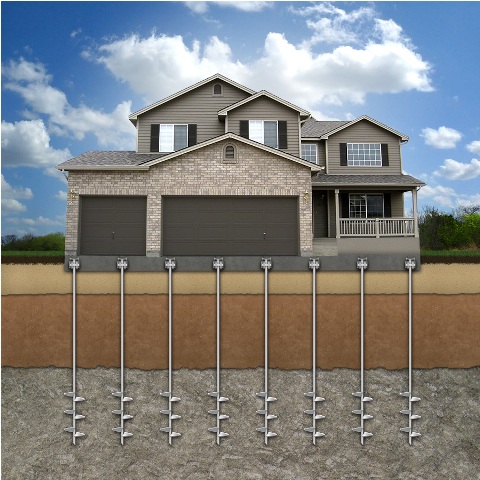If you're looking for information on helical piers, you've come to the right place. Helical piers are a common type of foundation pier used in both residential and commercial construction. Please note that there is no difference between helical piers and helical pile foundations. Both terms refer to steel shafts with helical blades that are driven into the ground to provide support for structures.
In this article, we'll cover everything you need to know about helical pier foundations, including what are helical piers. how they work, and their many benefits.
What are Helical Piers?
Helical piers are foundation support systems that consist of steel shafts with helically-shaped blades. These piers are driven into the ground using hydraulic equipment, and they can be used to support both new construction and existing structures.
They are most commonly used in situations where the soil is too weak or unstable to support traditional foundation methods such as driven piles or drilled shafts. Helical piles are also used in areas where there is limited space for equipment, making them ideal for tight urban sites.
The helical piers come in a variety of sizes, depending on the application. The most common sizes are 3/8 inch, 1/2 inch, and 5/8 inch. The piers are also available in a variety of weights, depending on the application. The most common weights are 30, 60, and 90 pounds.

How do Helical Piers Work?
Helical piers work by transferring a load of a structure from unstable or poor soil to more stable soil or bedrock. The helically-shaped blades on the pier act as screws, providing a secure connection between the pier and the ground. The pier is then connected to the structure, allowing the load to be transferred to the pier and away from the unstable soil. This can provide a more stable foundation for the structure and can help to prevent foundation settlement and other damage.
How to Install Helical Piers?
Followings are the stages followed during helical pier installation:
Excavation
The dig site is excavated to the specified depth using a variety of equipment. The excavation is then backfilled with gravel to improve the stability of the pier.
Drilling
A hollow drill bit is used to bore a hole through the soil and into the bedrock or stable soil below.
Insertion
The pier is inserted into the drilled hole and secured in place.
Grouting
A grout mixture is injected into the space around the pier to further secure it in place and to fill any voids.
Testing
The pier is tested to ensure that it can support the loads that will be placed on it.
Backfill
The excavation is backfilled with soil and compacted to finish the installation.
When Should Helical Pier Foundation be Used?
Helical piers should be used when you need a quick, easy, and versatile solution for foundation support. They can be used in a variety of applications, including new construction, repairs, and retrofits. Helical piers are also less expensive than other foundation support systems, making them a great option for budget-conscious homeowners.
Residential applications for helical piles include new home construction, additions, decks, porches, and garages. They can also be used to support light poles, basketball goals, and other outdoor structures.
Commercial applications include office buildings, shopping centers, and industrial parks. Helical piles are also commonly used to support cell phone towers and wind turbines.
Advantages of Helical Piers
There are many advantages and benefits to using helical piers.
- Small disturbance: The helical piers screw into the ground, causing a minimal ground disturbance.
- Quick installation: The helical piers are installed quickly and efficiently, oftentimes in less than a day.
- Easy access: The helical piers are installed from the exterior of a building, meaning that there is no need to move equipment around the inside of a structure.
- Cost-effective: The helical piers are a cost-effective way to stabilize a structure.
- No heavy equipment needed: The helical piers are installed using a hand-held power drill.
- Flexibility: The helical piers can be used to stabilize structures that have already been built or to stabilize structures that are being built.
- Versatility: The helical piers can be used to stabilize a wide variety of structures.
- Environmentally friendly: The helical piers are made from recycled steel and are completely non-toxic.
- Ability to be removed: The helical piers can be removed if necessary.
Limitations of Helical Piles
There are some limitations to using helical piers.
- The load-bearing capacity of helical piles is limited by the torque that can be applied to the shaft during installation.
- The depth to which helical piles can be installed is limited by the length of the shaft.
- Helical piles are not suitable for very soft or loose soils.
If you're in need of foundation support, helical piers may be the perfect solution for you. Contact a local foundation expert to learn more about this innovative foundation support system. If you really get impressed regarding helical piers call helical pier contractors near you to do this job.

